How Much Does a Dog Obedience School Cost?
- Anja Boecker
- Updated: 2023-10-04
The sparkling eyes, the joyful wagging tail and the incomparable bond between man and dog are something very special. But like any good relationship, it needs a solid foundation. A dog school can lay that foundation. But what does a dog school cost? This guide will answer that question for you.
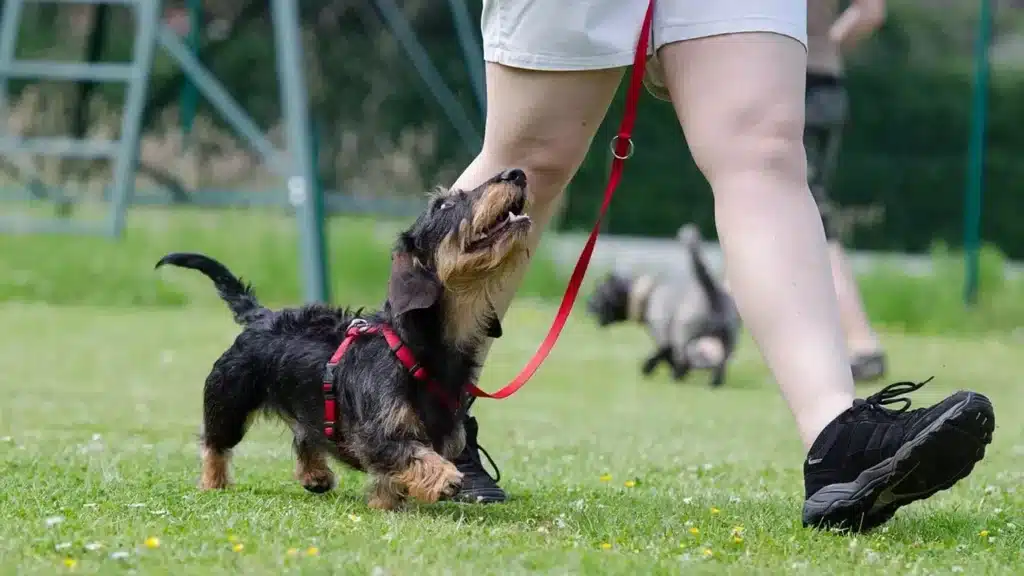
Every dog owner knows it: the proud moment when our pelt-nose looks at us with happy eyes after a walk. But until your dog goes through life safe, calm and happy, it needs a good education and perhaps the help of a dog school.
Dog training is especially important. Your dog can learn that:
- Improvement of the relationship between you and your furry nose
- Easier contact with strangers
- Improved walks
- Strengthened mental health
- Self-confidence encouragement
- your dog barks and growls less
- Socialization
- Safety and serenity
You don't have much experience with dogs? Then it can quickly happen that you feel overwhelmed. Because the education of a dog is not to be underestimated. A dog school can be the ideal solution here.
The Importance of a Dog Training
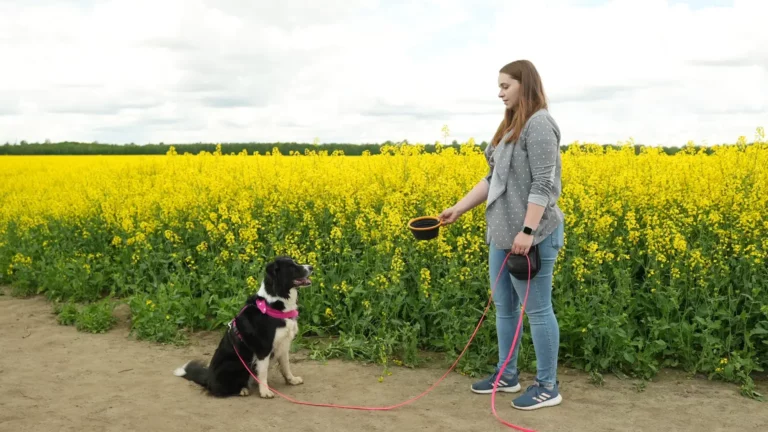
Dog training is essential not only for the well-being of your dog, but also for the peaceful coexistence of humans and animals. But why is it so important and how should it be designed to promote a harmonious relationship between your dog and you?
- Safety: A well-trained dog is easier to guide in many situations. This minimizes risks in traffic, in encounters with other dogs or people and prevents possible accidents.
- Social Acceptance: A dog that does not bark, does not pull on the leash and behaves quietly on public transport is perceived more positively by society. This makes everyday life much easier.
- Stress Reduction: The education creates clear structures and rules that give your dog security and composure. This strengthens his self-confidence.
- Responsibility: As a dog owner, you bear responsibility for the animal and its environment. A good education shows that you live up to this responsibility.
➡ Dog training should not be understood as a pure "command-obedience" relationship. At its core, it is about a deep bond and trust between human and dog.
Through training and education, you learn to better understand your dog's needs and signals, and vice versa. This strengthens your bond and mutual trust. Education enables clear communication. A well-trained dog understands what is expected of him, and the human learns to articulate his wishes and limits to the dog.
Modern parenting methods rely on positive reinforcement instead of punishment. This means that desired behavior is rewarded and undesired behavior is ignored or redirected. This promotes your dog's well-being and strengthens the relationship. Time spent together during training is valuable quality time. It promotes bonding and shows your dog that he is loved and appreciated.
Dog training is much more than learning commands. It is an important building block in the relationship between man and dog. A loving, consistent and understanding education lays the foundation for a harmonious coexistence and a deep, trusting bond between you and your dog. An investment that pays off in countless happy moments and a trusting relationship.
How a Dog School Helps
You have a dog for the first time? Then the education of your dog can be more difficult than for experienced dog owners. A dog school is the perfect solution for you.
Do you already have experience? Then we still recommend you to visit a dog school. There you will learn to better understand your darling. This in turn will improve your communication, which is an important part of dog training.
By meeting other dogs, your protégé gains important social experience. The basis of a good dog school is the involvement of master and mistress.
Your dog learns to recognize and respect certain boundaries. He also learns about the behaviors of different breeds of dogs. However, the focus of a dog school is also on you as the owner. The dogs learn different commands. They improve their social behavior through dog school.
A dog training school provides a structured environment where dogs and their owners can learn the basics of dog training as well as advanced training techniques. It is often the key to a harmonious human-dog relationship. Here are some benefits and ways a dog school can help:
Basic Obedience: Most dog training schools offer basic obedience classes that teach dogs simple commands like "sit," "down," "here," and "stay."
Socialization: Especially for puppies, socialization with other dogs and people is very important. In dog school they can gain positive experiences in a controlled environment.
Behavioral correction: For dogs with specific behavior problems, many dog schools offer special classes or one-on-one training to correct undesirable behaviors such as aggression, fear or excessive barking.
Bonding and communication: Training in a dog school can strengthen the bond between dog and owner. Both learn to communicate better with each other.
Safety: A well-trained dog is often also a safer dog. He will probably respond better to commands, which can be decisive in many situations, e.g. in traffic or when meeting other dogs.
Mental and physical exercise: Training exercises provide mental stimulation for the dog. Often there are also courses that emphasize the physical aspect, such as agility.
Advice and support: Dog trainers at dog schools are often a valuable resource for questions about nutrition, health, grooming and other aspects of dog life.
Advanced training: In addition to basic courses, many dog schools also offer advanced courses that teach special skills or tricks.
Community: For dog owners, it's often also an opportunity to network with like-minded people, share experiences and make friends.
Promote positive training methods: Good dog training schools use reward-based training methods that are effective, humane, and promote the dog's well-being and self-confidence.
Overall, a dog school provides a solid platform to get the most out of the relationship between man and dog. However, it is important to choose a school and trainer whose methods and philosophy are in line with your own beliefs and the dog's needs.
This is what you and your dog can learn
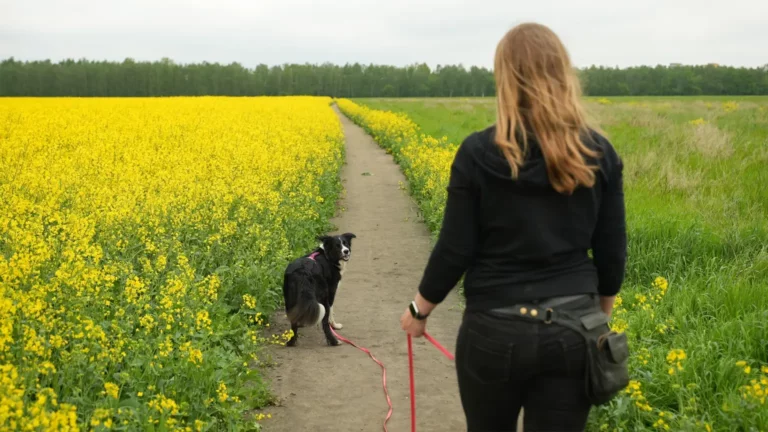
In a dog school, both your dog and you will be taught various skills and abilities. The exact teaching content can vary from school to school and from course to course:
- Basic Obedience: These include the basic commands such as "sit", "down", "stay", "come", "heel" and "off". These commands form the basis for a good coexistence and are useful in many everyday situations.
- Leash Leadership: Dogs learn to walk without pulling on the leash. This makes walks easier and means less stress for both dog and owner.
- Socialization: Especially in puppy schools, socialization is a central theme. The dogs meet conspecifics of different sizes and breeds and learn to behave correctly and in a friendly manner.
- Dealing with distractions: Dogs are trained to obey commands even in the presence of distractions (e.g. other dogs, cars, bicyclists).
- Abort signals: In critical situations, it is important for dogs to immediately stop an undesirable behavior when given a signal. This can be practiced in dog school.
- Playful training: Through playful exercises and activities, the learning behavior of the dog is promoted and strengthened.
- Special Training: Depending on the dog school, special training such as agility, protection service, tracking or therapy dog training is also offered.
- Problem behavior: For dogs with specific behavior problems (e.g. aggression, fear or separation anxiety), specific training methods and strategies can be taught.
- Holder Training: Not only your dog, but also you as an owner learns in the dog school. Here, tips are given on how to deal with your dog properly, the basics of dog training and dog behavior are taught and it is shown how to give your dog clear and consistent signals.
- Everyday Training: Some schools also offer courses to practice everyday situations such as visiting the vet, driving a car, or going to the coffee shop.
In a dog school, not only the behavior of your dog, but also the communication and bond between your dog and you is trained and promoted. It's about becoming a team and mastering everyday life harmoniously and safely.
How to Recognize a Good Dog Obedience School
Finding a good dog school is critical to a positive learning experience for you and your dog. Here are some criteria and tips to help you identify a good dog school:
Positive training methods
Modern dog training schools use positive, reward-based training methods. Punishment or aversive methods should be avoided. Make sure trainers use positive reinforcement such as treats, praise or toys.
Transparent methods
A good dog training school should be open to questions and be able to clearly explain their training methods.
Qualified trainers
Find out about the qualifications and experience of trainers. There are various certificates for dog trainers. A qualified trainer will also constantly educate himself.
Smaller groups
Smaller groups allow for more individualized attention for both dog and owner. This is especially important to ensure that specific problems or questions are addressed.
Cleanliness and safety
Facilities should be clean and provide a safe environment for the dogs, including secure fencing or partitions.
Observation possibility
Many good dog schools allow potential clients to attend a lesson before signing up. So you can get an idea of the methods and the atmosphere.
Recommendations and ratings
Word of mouth or online reviews can be helpful. Ask other dog owners about their experiences or look at reviews online.
Wide range of courses
A wide range of classes - from puppy classes to advanced or specialty classes - shows the school's focus on continuous learning and dog development.
Interaction with the dogs
Pay attention to how the trainers handle the dogs. They should be patient, consistent, loving and have clear communication with the dogs.
Relationship between theory and practice
Besides practical training, a good school should also teach theoretical knowledge, e.g. about dog behavior, communication signals etc.
Clear rules and guidelines
These include immunization requirements, classroom conduct rules, and other safety guidelines.
Feedback
A good dog training school will give you regular feedback on your dog's progress and be open to your feedback.
If you take all of these points into consideration and listen to your gut, you will likely find a dog training school that is right for you and your dog.
Remember that there is no one-size-fits-all solution in dog training. What works for one dog may not work for another. A good dog training school is aware of this and flexible enough to cater to the individual needs of both dog and owner.
Dog Obedience Schools: Cost
It's time to take a look at a dog obedience school's cost. This may vary greatly from institute to institute.
- What goals do you want to achieve?
- Is it an adult dog or a puppy school?
- Would you like to have group or individual lessons?
- Is the "online dog school" option something for you?
These are just a few questions of many that affect the cost of a good dog training school.
Therefore, we have divided the topic "Cost dog school" into four different categories.
- The cost of a puppy school
- Cost of a dog school for adults
- Cost of individual training
- Cost of a group course
- Online dog school costs
1) The Costs of Puppy Schools
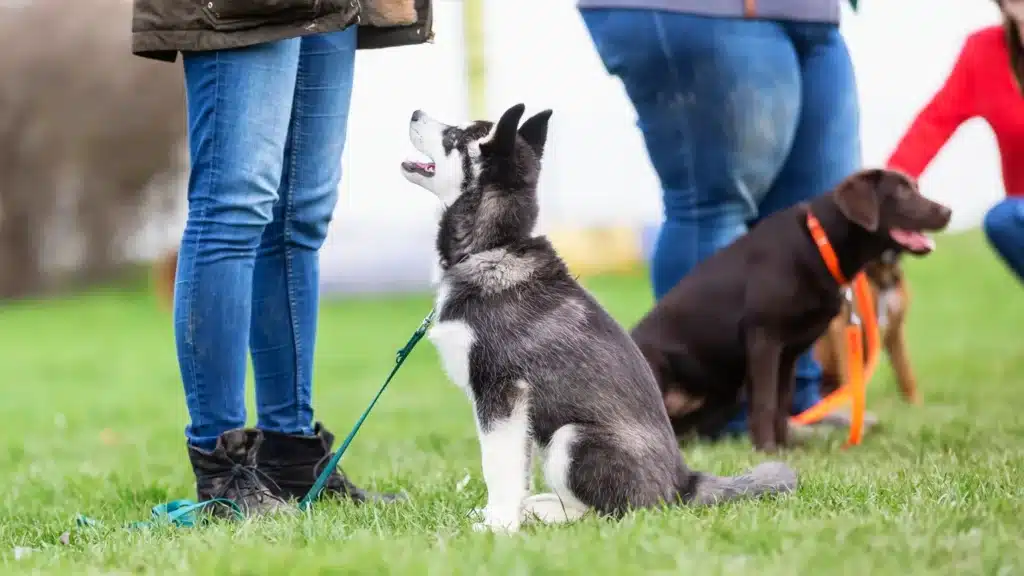
The cost of courses at a dog training school can vary depending on the type of course, the duration, the location, and the trainer's qualifications. In general, prices for puppy classes, young dog classes and adult dog classes at the same facility are often similar, but there are some factors that can affect the cost:
- Course Content: Puppy classes often focus on basics such as socialization, simple commands and avoiding unwanted behavior. Courses for young or adult dogs may focus on more specific skills, advanced obedience or behavior correction. The more specialized or advanced the course, the higher the price may be.
- Duration of the course: An intensive course that extends over a longer period of time can be more expensive, whether it is designed for puppies, young dogs or adult dogs.
- Specialization of the trainer: A trainer who specializes in certain breeds, behavior problems or training techniques may charge higher fees.
- Group size: Courses with fewer dogs (and thus more individual attention per dog) can be more expensive.
- General pricing: Some schools offer puppy classes as an introductory offering at a lower price to attract new customers. Others might increase the price of puppy classes, as new dog owners are often willing to invest in the education of their new family member.
There is no fixed rule according to which puppy courses are more expensive or cheaper than courses for older dogs. It is always advisable to compare the prices and contents of the different courses and choose the most suitable course for your dog and your own situation.
The cost of a puppy school can vary depending on the region, the facility, the experience of the trainer, and the length and type of class. Here is a general overview:
Group courses
A group course for puppies, which often lasts between 4 and 8 weeks, can cost between 80 and 150 euros. These courses have the advantage that the puppies can interact with other dogs in a social environment, which is very useful for their socialization.
Private lessons
If you decide to have individual lessons to give your puppy special attention or to train certain behaviors, the cost can range from 50 to 150 euros per hour.
Combined offers
Some schools offer combined packages that include both group and individual lessons. The cost of such packages can vary, but often offer better value for money than booking individual lessons.
Location
In urban areas or regions with a higher cost of living, puppy school prices tend to be higher.
Additional services
Some puppy schools offer additional services such as puppy play sessions, special workshops or seminars that may be charged separately.
Check in advance with several puppy schools in the area for prices, course content and methods. When choosing a puppy school, consider not only the price, but also the training method, the experience of the trainer and the general atmosphere.
Choose a positive and supportive environment that is beneficial to both your puppy and you.
2) The Cost of Dog Schools for Adults
The cost of a dog school can vary greatly depending on location, trainer experience, type of training, and other factors. Here are some general considerations and guidelines for dog school costs:
Private lessons vs. group lessons
Private lessons are usually more expensive than group lessons. A trainer who comes to your home can charge between 50 and 100 euros (or more) per hour, depending on the duration and travel distance. Group classes are often less expensive because the cost is spread over several participants. A group course lasting several weeks can cost between 80 and 200 euros (or more), depending on the duration and content.
Course type
Specialty courses such as agility training, therapy dog training, or advanced obedience classes can be more expensive than basic courses.
Course duration
An 8-week course will obviously cost more than a 4-week course, but you should also consider the total training time. Sometimes longer courses offer better value for money.
Location
In cities or areas with a higher cost of living, dog training prices may be higher than in rural areas.
Additional offers
Some schools offer additional services, such as dog boarding, grooming or behavioral counseling, which may affect the cost.
Experience and qualification of the trainer
A trainer with many years of experience, special qualifications or a particularly good reputation can charge higher prices.
When deciding on a dog school, I recommend you compare prices and offers from different schools in your area.
Pay attention not only to the price, but also to the trainer's methods, customer reviews, and the atmosphere of the school. It is important to choose an environment where you and your dog can feel comfortable and learn effectively.
3) The Cost of Individual Training Sessions
The cost of private lessons or one-on-one instruction at a dog training school can vary widely based on a number of factors. Here is a general overview:
Price range
The price for a one-to-one lesson with a dog trainer can range from 50 to 120 euros per hour, depending on the location, the trainer's experience and specialization.
Travel costs
If the trainer comes to your home, there may be additional travel costs depending on the distance and effort involved. Some trainers offer a flat rate for travel expenses, while others charge by the kilometer.
Experience and qualification of trainers
Trainers with special qualifications, certifications, or years of experience may charge higher prices. Specialists for specific behavioral problems or therapies may also be more expensive.
Location
In larger cities or in areas with a higher cost of living, prices for private lessons may tend to be higher.
Duration and packages
Some trainers offer longer individual sessions or packages of multiple sessions at a reduced total price.
Type of problem or training objective
A specific behavior problem that requires special expertise may cost more than general obedience training.
As always, it is advisable to compare prices and services of different trainers. It is also important to find the right trainer for your dog's specific needs and training goals.
When choosing, you should look not only at price, but also at training methods, communication with the trainer, and customer reviews. A good trainer should have a positive, reward-oriented approach and be willing to answer questions and explain the training approach.
4. cost of a group course
The cost of a group class at a dog training school can vary based on a number of factors. Here is a general overview:
Basic obedience courses
A basic dog training course, often called "puppy school" or "basic obedience", costs between 80 and 150 euros for a course of 6 to 8 weeks.
Advanced obedience courses
Courses for advanced obedience or special skills (e.g. trick training) cost between 100 and 200 Euros for a course of 6 to 8 weeks.
Special courses
Courses such as agility training, nose work or other specialized skills cost between 100 and 250 euros for a 6-8 week course, depending on equipment and training facilities.
Location
Prices may be higher in larger cities or areas with a higher cost of living.
Trainer experience
Trainers with a lot of experience, certifications or a good reputation can charge higher prices.
Group size
Courses with a smaller number of dogs can be more expensive, as they often offer more intensive supervision and more individualized instruction.
5. cost of online dog school
Online dog schools have gained popularity in recent years, especially with the advent of technology and the ability to learn through video platforms. The cost of online dog training schools can vary depending on a number of factors. Below is a general overview:
Individual videos or webinars
Some online dog schools offer individual instructional videos or webinars on specific topics. Prices here can range from free to around 30 euros per video or webinar.
Monthly subscriptions
Many online dog schools offer monthly memberships or subscriptions. This gives access to a collection of videos, articles, and possibly live webinars. The cost ranges from 5 to 30 euros per month.
Comprehensive online courses
Some platforms offer comprehensive online courses that span several weeks or months and provide a structured learning experience, similar to a physical dog school. Prices for such courses can range from 50 to 300 euros or more, depending on the scope and content of the course.
Interactive support
Some online dog schools offer additional interactive services where you can get direct feedback from a trainer via live chats, video calls, or video analysis. These interactive services can increase the cost.
Additional resources
Additional materials such as e-books, worksheets, or special video content may either be included in the total price or incur additional costs. When considering an online dog training school, it's important to check the content offered, the trainer's qualifications, customer reviews, and any trial content offered.
Another advantage is that you can often learn more flexibly by setting your own learning pace and reviewing content over and over again.
Note that an online dog school cannot replace the physical socialization and interaction offered in a traditional dog school. Therefore, a combination of both approaches may be ideal for many dog owners.
If you are looking for a practical online solution for dog training, take a look at our Hundeo App throw - a modern way to train his furry nose from home.
Dog Clubs: An Affordable Alternative
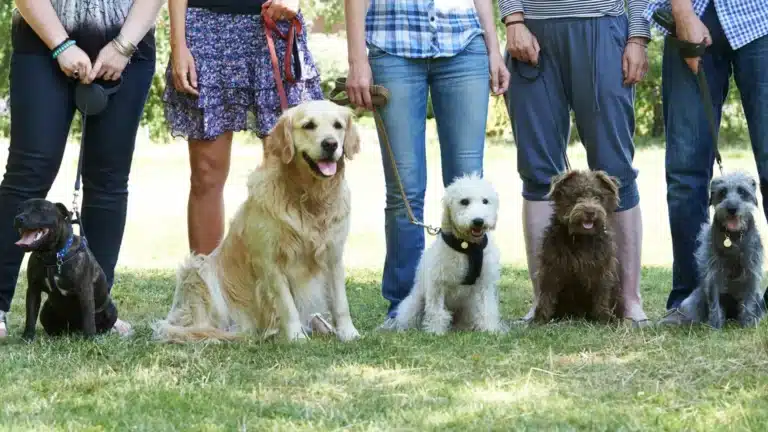
Dog clubs differ from dog schools in several ways. The most important difference is the significantly lower price of the clubs. Mostly only the annual membership fee is due. For it however also honorary co-operation in the association is expected. Because also the coaches in the association work voluntarily and receive no salary, like the coaches in the dog schools.
In addition, the club's goals are in the foreground, and training often takes place only in large groups and at fixed times, mainly on weekends. It is therefore not always possible to cater to the individual. Which courses are offered and what the offer looks like in individual cases naturally varies from club to club.
Dog clubs bring together people who share a common passion - the love of dogs. This creates a unique atmosphere of exchange and support.
Many dog clubs have members who have been keeping and training dogs for years or decades. Their knowledge and experience is often invaluable and they are usually willing to share this knowledge with newcomers.
Since dog clubs often work on a voluntary basis and do not pursue commercial interests, their courses and training offers are usually cheaper than those of professional dog schools.
Depending on the club, different training methods and courses are offered, from puppy school to agility and breed-specific clubs. Dog clubs often organize tournaments, competitions and other events. As a member, you often have the opportunity to participate in or attend such events.
Clubs provide an excellent platform for the socialization of the dog. At regular meetings and classes, dogs can practice interacting with conspecifics. Many dog clubs set standards for their trainers and use established and proven training methods. This often guarantees a high level of training.
Even though training is often cheaper, sometimes club fees may apply. Not every town has a dog sports club and sometimes the offer is limited.
Conclusion
Dog clubs can be a good and often cheaper alternative to commercial dog schools. They offer not only training, but also a community of dog lovers. It's worth exploring local clubs and finding out what they offer.
Group Training vs. Individual Training
Various factors play a role in the decision "group training vs. individual training". For specific behavioral problems or challenges, we recommend individual training. This is associated with higher costs. But even with this form of training, you will achieve your desired goals in the long term.
Is your darling grown up and still knows hardly any rules? Then we also recommend the individual training. If you have a puppy, group training is just right for you. Contact with other dogs and breeds is an important part of dog training in the first years of life.
Basically, every form of training has its advantages and disadvantages that need to be weighed up. A trial course or a free consultation will make the decision easier.
The decision between group training and one-on-one training depends on several factors, including your dog's individual needs, learning goals and available budget.
| Type | Advantage | its downside |
|---|---|---|
| Group training |
|
|
| Individual training |
|
|
Whether group training or individual training is more appropriate depends on the individual case. For dogs that need social interaction or where budget is an issue, group training may be the right choice.
For dogs with specific behavior problems or for owners who want a customized training plan, one-on-one training is often more beneficial. It is important to consider the needs and goals of both the dog and the owner to make the best decision.
Frequently Asked Questions
The cost of a dog school varies greatly. They depend on the age of the dog and the type of course. The fewer participants in a course, the higher the price often is. You can find more information in our guide.
Especially for a puppy it is important to gain social experience and thus strengthen its social competence. Anyone who has no experience with dogs and adopts a puppy or an adult dog should definitely visit a dog school.
In dog schools, you learn how to handle your dog and how he listens to your commands. Puppies also learn how to interact with other dogs in group classes.
No, dogs can learn at any age.
My Conclusion
Investing in a dog training school is more than just a financial decision.
The aim is to create the basis for a harmonious relationship between man and dog and to enrich life together.
While costs can vary depending on whether you choose group training, one-on-one training, an online dog school or a dog club, the value of training should never be underestimated.
Each option offers its own benefits and may be the right one depending on the individual needs of the dog and owner. Ultimately, the best investment is the one that strengthens the bond, keeps the dog safe and happy, and promotes peaceful coexistence.

My name is Anja Boecker, and I am a certified dog trainer and behavior consultant. With these articles, I want to help you to understand your dog better and to build an inseparable bond.
Share Now:

